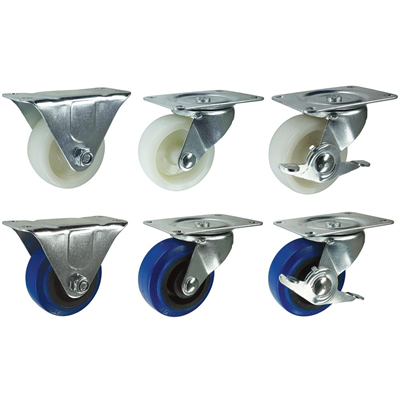Enhancing workplace efficiency with rigid casters involves optimizing their use in various applications to improve productivity, safety, and overall operations. Here are several ways to achieve this:
- Load Capacity Matching: Ensure that the rigid casters used in your workplace match the load requirements of your equipment or carts. Using casters with the appropriate load capacity helps prevent overloading and equipment damage.
- Proper Wheel Material Selection: Select the right caster wheel material for your application. For example, choose polyurethane wheels for smooth and quiet operation in indoor settings, and steel or cast iron wheels for heavy-duty or rugged environments. The appropriate wheel material ensures durability and efficient performance.
- Optimized Layout and Configuration: Plan and configure your equipment, carts, or machinery layout to use rigid casters effectively. Consider the arrangement of rigid and swivel casters to strike the right balance between stability and maneuverability.
- Preventing Overturning: To avoid tip-overs or instability, ensure that the center of gravity of your equipment or loads is correctly positioned. Distribute the weight evenly on all caster wheels and adjust the positioning if necessary.
- Maintenance and Inspection: Implement a routine maintenance schedule for your rigid casters. Regular inspections, cleaning, and lubrication can extend their service life and maintain efficiency. Replace worn or damaged casters promptly.
- Proper Training: Train employees to operate equipment with rigid casters safely and efficiently. They should understand load limits, braking systems, and the need for precise control.
- Integration with Materials Handling Systems: Integrate rigid casters into your materials handling and logistics systems to streamline the movement of materials and products. Conveyor systems, carts, and shelving units can all benefit from rigid casters for controlled movement.
- Enhanced Safety Measures: Rigid casters contribute to workplace safety. Ensure that equipment with rigid casters is equipped with additional safety features, such as wheel locks and ergonomic handles, to reduce the risk of accidents.
- Noise Reduction: Rigid casters can often produce less noise and vibration than swivel casters. This can contribute to a quieter and more comfortable work environment for employees.
- Environmental Considerations: Choose rigid casters that are designed for the specific environmental conditions of your workplace. For example, corrosion-resistant casters are suitable for wet or chemical-laden environments, while high-temperature casters are ideal for extreme heat conditions.
- Inventory and Warehouse Management: In warehouses and distribution centers, rigid casters on carts and shelving units improve the efficiency of inventory management and order fulfillment. They allow for stable and precise movement in narrow aisles and crowded storage spaces.
- Custom Solutions: Depending on the nature of your workplace, you may benefit from custom caster designs or modifications to address specific challenges and increase efficiency.
By incorporating these strategies, you can harness the benefits of rigid casters to optimize workplace efficiency, minimize downtime, and improve the overall performance of equipment and material handling systems. The versatility and stability of rigid casters make them valuable assets in various industries and work environments.


